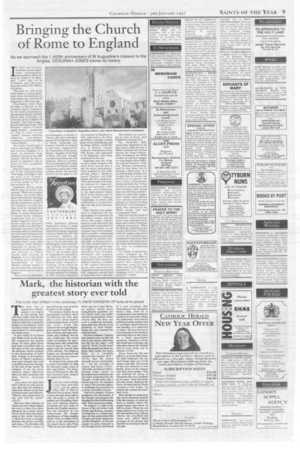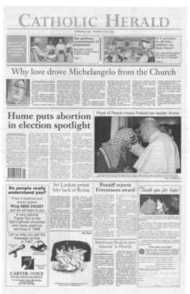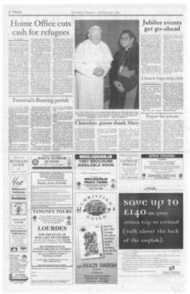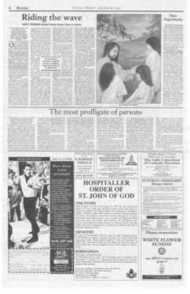Page 9, 3rd January 1997
Page 9

Report an error
Noticed an error on this page?If you've noticed an error in this article please click here to report it.
Tags
Share
Related articles
Move Over, St Augustine, There Were Other Saints Who Were...
Christians Give Thanks For Augustine
We're Waiting For Israel To Convert, Says Cardinal
Why We Must Give Our Support
Anniversaries Marked In Bath
Bringing the Church of Rome to England
As we approach the 1,400th anniversary of St Augustine's mission to the Angles, DEBORAH JONES traces its history
IN 1997 THE CHURCH celebrates several significant anniversaries, among them 1,450 years since the death of St Benedict, 1,400 that of St Columba, and 100 years since the death of St Therese of Lisieux.
This week we look at the event which is causing excitement in the Kentish town of Canterbury, the arrival of St Augustine 1,400 years ago.
Christianity had been brought to Britain in the centuries before Augustine by the Celtic missionaries, among them Ninian, Patrick, David and Columba (or Colmcille as he is known in Ireland). They had evangelised the followers of the "Old Religion", echoes of whose pagan fertility pantheism we find in some of our "quaint" customs involving maypoles, corn-dollies, touching wood and invoking "white rabbits".
The Celtic Church had to retreat westwards into Wales and western England as a result of invasions from northern Europe in the fifth century. This left the East to revert to paganism and to await the new evangelism from Rome.
Pope St Gregory the Great (he of the reputed saying "non Angli, sed Angeli") sent the prior of St Andrew's monastery in Rome and 40 or so of his monks in 596, to this northern isle.
Augustine and his group almost gave up before ever arriving. When they reached Provence, the locals filled them with such dire warnings about the barbaric English and the treacherous nature of the Channel crossing that they were for turning back and they sent Augustine to Rome to obtain permission to return home. Gregory would have none of it, and packed Augustine back to his monks with the increased status of abbot and the Pope's personal assurance that all would go well. In obedience, but with what feelings we can imagine, the party continued through France, crossing the Channel from a port called Quentavic, near Etaples, sometime in spring 597. Tradition records that Augustine returned to France shortly after arriving in England, to be consecrated as bishop by St Virgilius, metropolitan of Arles. Modern scholars incline to the view that this took place on the mission party's way to England.
They arrived at Ebbsfleet,
near Ramsgate, on the Isle of Thanet, and were welcomed graciously by Ethelbert, king of Kent. Although not baptised himself, he seemed to have been impressed by the Christianity of his queen, Bertha, daughter of the king of Paris, who had brought with her from France her own chaplain, Bishop Luidard. They worshipped in the small church of St Martin outside Canterbury, where part of the walling within the present church can be dated to the 590s. Ethelbert allowed Augustine's party to lodge and preach in Canterbury, himself becoming a baptised convert at Pentecost, 597. His conversion enabled the mission to spread beyond the city, so the monks spent the following few years in preaching, building and restoring churches over a wider area. One of the churches given to Augustine for restoration, on which he built his cathedral, was said to date back to Roman times. Augustine's building, beside which the monks built their lodging, was later developed into the present cathedral by Lanfranc in 1070. A further monastery was founded by Ethelbert in 598, dedicated to Ss Peter and Paul, to provide a burial place for the archbishops and the kings of Kent, outside the city, as Roman custom required. Foundations of the 598 church, later dedicated to St Augustine, have been excavated on this site.
Augustine sent two of his monks to Pope Gregory with news of his success and to ask for more missionaries. They returned in 601 with, among others, Mellitus, Justus, Paulinus and Rufinianus (all later canonised). They also brought with them the pallium for Augustine, plate and vestments, relics and books one of which may be the sixth-century Italian Book of the Gospels now at Corpus Christi College, Cambridge, on which each archbishop of Canterbury takes his oath at his enthronement.
Pope Gregory sent guidelines to Augustine for the developing of a hierarchy for the whole country, and the advice that pagan temples were not to be destroyed, but purified and consecrated for Christian worship. Local customs were to be retained, where possible, substituting days of dedications and feasts of martyrs for heathen festivals since, as Gregory put it, "he who would climb to a lofty height must go by steps, not leaps". In 604, two new bishoprics were founded, Rochester and London, where Justus and Mellitus respectively were installed as bishops. Laurence, a member of the original missionary group, was consecrated by Augustine as his successor in 604. Augustine himself died in either that year or the next. The mission was successful, at least in Kent, until Ethelbert's death in 616.
The Venerable Bede reports that Augustine at one time tried to enlist the help of Welsh Christians for mission among the Anglo-Saxons. After travelling to the Welsh borders, he and they engaged in a long dispute about different customs between Celtic and Roman Christianity, until he won them over by healing a blind man. At a second meeting, though, they thought him too proud and refused to co-operate. He then, rather uncharitably, threatened them that "if they would not accept peace with their brethren, they should have war with their enemies". Some 10 years after Augustine's death, many Britons were indeed attacked and defeated at Chester by King Ethelfrith of Northumberland, who massacred the Welsh monks who had accompanied them.
After 619 and the death of Ethelbert, anti-Christian forces were unleashed and in Kent and London Christians suffered persecution. While the Bishops of Rochester and London fled back to France until the pagan opposition cooled, the archbishopric remained in Canterbury thus ensuring its pre-eminence in the south, and forming a base for later re-evangelising missions.
o For details of anniversary events arranged by the Canterbury Tourist Office to celebrate how 1,400 years of history have shaped this important centre of Christianity, write to: PO Box 198, Canterbury CT1 lUX; or telephone 01227 763763; or fax 01227 764922.
blog comments powered by Disqus











